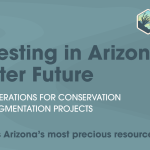Oregon’s 2023 legislative session concluded with a wide-ranging drought package passing through the House and the Senate, enabling key investments necessary to building a water-secure future for Oregon’s communities and ecosystems.
The investments come at a critical moment as climate change is impacting water resources throughout Oregon. The vast majority of the state remains vulnerable to drought despite the abundant mountain snow that accumulated this past winter. Persistent drought conditions have dried up critical ecosystems like streams and wetlands, leaving endemic endangered species at risk and creating tension in communities. For some Oregonians, turning on the tap means either contaminated water or no water at all. The successes of this session are important steps on the path toward addressing these issues.
A $174 M investment in water
Oregon State Representatives Ken Helm (D-27) and Mark Owens (R-60) led the development of a drought and water security package, which was recently passed by the House and the Senate and included key policies and $174 million in funding. The bi-partisan legislative package’s stated aims are to:
- Modernize Oregon’s critical irrigation infrastructure to better serve the families, farms, fish and wildlife that interact with our systems.
- Protect, enhance and restore critical sources of drinking and other types of water systems that support local industries and ecosystems.
- Bolster water-related data necessary to more efficiently detect risks and coordinate water management.
One component of the package provides $3 million for Oregon State University Extension Service to establish an agricultural water management technical assistance program. The program increases the state’s technical capacity and funds new measurement equipment and tools, including the use of satellite-based evapotranspiration data. The program will provide farmers across the state with access to locally tailored resources, data, and tools that support efficient, data-driven water use while producing the food and fiber we depend on.
Additionally, the package includes funding to explore the use of voluntary agreements in the Harney Basin as a tool to address groundwater overdraft. Voluntary agreements have been authorized under Oregon statute for decades but have never been tested. Now, the Harney Basin community is interested in exploring how they might use these agreements to implement water management tools prioritized by the community.

On the Malheur National Wildlife Refuge in the Harney Basin, this American Avocet and its chicks rely on groundwater-fed rivers that flow into and sustain the Refuge’s wetlands. Image: Barbara Wheeler, American Avocet, CC by 2.0.
Partnership advances key conservation outcomes
EDF is part of the Oregon Water Partnership (OWP), a coalition of seven conservation organizations that aim to secure reliable access to cold, clean water to sustain healthy communities, livelihoods, and ecosystems.
One of OWP’s policy priorities passed early in the session, making split-season leasing a permanent water management tool. This voluntary program can help keep our rivers flowing by providing farmers with flexibility around how they use their water rights, with the option to leave some of it in the river when fish and wildlife need it most. The bill, which had strong bipartisan support, was signed into law by Governor Kotek on May 8, 2023.
OWP also supported investment in the state’s Water Availability Reporting System, which determines surface water availability. The $2.2 million allocated will allow Oregon Water Resources Department to invest in equipment an necessary to develop and deliver scientifically robust data used in tools and models. These data can be used to support better informed decision-making, particularly around the allocation and use of the state’s water resources.

At Opal Springs on the Crooked River, groundwater rises to the surface, providing year-round flows that support wildlife and recreational activities. Image: Rachel O’Connor.
Systems change instead of band-aid fixes
The investments made in the 2023 session are steps on the path to creating a water management system in Oregon that can provide clean and reliable water supplies to support the wide array of instream and out-of-stream uses. Instead of a temporary fix, these investments are improving the ways in which we measure and manage water, and how we include various perspectives in that process. There is still much work to be done, however, to ensure that watersheds are healthy, groundwater basins are in balance, and that we can adapt to hydrologic variability and uncertainty under climate change.
Water is deeply woven into the identity of Oregon and Oregonians, and state leaders must continue to make water security a priority. The passage of the drought package and other water-related bills illustrate how vital our water resources are for communities, wildlife, agriculture, recreation, sustenance, and cultural beliefs.
EDF thanks the Governor’s office, legislative leadership, agency staff, and all of the stakeholders that have had a hand in advancing this vital legislation and elevating water as a key issue in the


